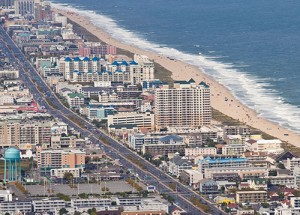
OCEAN CITY – The “road diet” concept is not so much a diet anymore as the Town of Ocean City has given the State Highway Administration a new directive in changing Coastal Highway to better enhance pedestrian safety.
For years, the Town of Ocean City and the State Highway Administration (SHA) have been back and forth over the concept of a “road diet,” formally titled the MD 528 Community Safety and Enhancement Project, which would essentially reduce the travel lanes on Coastal Highway to potentially add a designated bike lane and widen sidewalks. However, in the past year the concept has become closer to reality.
According to SHA, the need for the project is due to existing sidewalk widths being insufficient for current pedestrian volumes and to bring sidewalks, entrances, pedestrian ramps and signals up to current ADA standards.
Also, many pedestrians currently cross Coastal Highway at undesirable locations. A Pedestrian Safety Study resulted in 27 percent of pedestrians crossing mid-block. From January 2008 to August 2012, there were 47 pedestrian accidents, one of which was fatal, in the project scope.
Currently, Coastal Highway is an eight-lane roadway consisting of three, 11-foot travel lanes and a 14-foot bus/bike lane with five-foot sidewalks on each side that contain several obstructions. The median is 14-feet wide consisting of brick pavers and some plantings that do not discourage mid-block crossings. The median allows for a 10-foot left turn lane at intersections.
The proposed project limit is from Route 90 to Convention Center Drive on Coastal Highway, which is approximately 1.4 miles. Within this section, there are 10 signalized intersections with two pedestrian crossing intersections on 49th Street and 54th Street. There are 59 entrances with 38 on the southbound side and 21 on the northbound side.
In December, SHA proposed a “3 Lane Alternate” with a six-lane roadway, consisting of 12-foot travel lanes, a 15-foot bus/bike lane with a minimum of 10-foot sidewalks in each direction. The median would be 14 feet wide with a 10-foot left turn lane at intersections. SHA also presented options in installing a median barrier to deter pedestrians from crossing the median mid-block.
At that time, the project schedule called for the final design being completed by December of 2015 with construction starting in fall of 2016. The design stage has been funded with $2.4 million.
The Transportation Commission followed up by reviewing the progress of the Pedestrian Safety Study that identified a list of near-term, mid-term and long-term improvements along Coastal Highway to enhance pedestrian safety.
Near-term improvements included reducing the speed limit south of Route 90 to 35 mph, relocate all bus stops to upstream of signalized intersections, install pavement marking with advance crosswalk warnings similar to the markings located at 49th Street and adjusting signal timing by shortening mainline cycle lengths to improve pedestrian safety by allowing more frequent pedestrians phases. All of the near-term improvements have been completed.
The mid-term improvements focus on deterring pedestrians from crossing at mid-block and outside of signalized pedestrian crosswalks by installing a median barrier, as well as installing three pedestrian actuated signals on 42nd, 49th and 54th streets, which have all been installed leaving the median barrier the only mid-term item to be completed.
The commission voted to recommend SHA hold off on the “3 Lane Alternate” and dedicate the design funding toward completing mid-term improvements on all of Coastal Highway more specifically the median barrier with lighting.
SHA met with the Transportation Committee in May to give the “3 Lane Alternate” another shot, and by the end of the presentation committee members admitted the concept was starting to grow on them, recognizing “walkable communities” is the wave of the future. However, questions remained over how the lanes of traffic would convert at Route 90 and Convention Center Drive as well as how construction would be carried out throughout time.
On Tuesday morning, the Transportation Commission returned to the table with SHA, who proposed construction would be separated into three phases. Phase one would be median enhancements with a fence, lighting and landscaping; phase two would be widening the sidewalks; and phase three would be conversion of travel lanes.
SHA also presented models on how the travel lanes would convert at the ends of the project limits, and how traffic would be affected.
By the end of the presentation, members were back to square one. The political members of the committee made it clear they have no interest in dropping a travel lane on Coastal Highway at this time and wanted SHA to focus on a median barrier throughout Ocean City, not just in the project limits.
Councilman Dennis Dare pointed out the current bus/bike lane is 14 feet wide, except for in certain locations where in an effort to comply with ADA standards SHA has extended the gutter line causing the bus/bike line to be reduced to 11 feet, and in this case bus drivers have been trained to merge into the travel lane to go around bicyclists. Therefore proving the bus/bike lane could be reduced to the same width of the three travel lanes making room for widened sidewalks without removing a lane of traffic.
Ultimately, the commission agreed with SHA’s concept of the first phase of a median barrier, lighting and landscaping but along all of Coastal Highway and the second phase of expanding the sidewalks, but had no interest in third phase of reducing travel lanes until the results of the first two phases are determined.
The commission voted to send a favorable recommendation to the full Mayor and City Council to have a letter drafted to the Maryland Department of Transportation outlining the Town of Ocean City’s goals within the MD 528 Community Safety and Enhancement Project that SHA District Engineer Donnie Drewer will move up the latter to headquarters in Baltimore.
